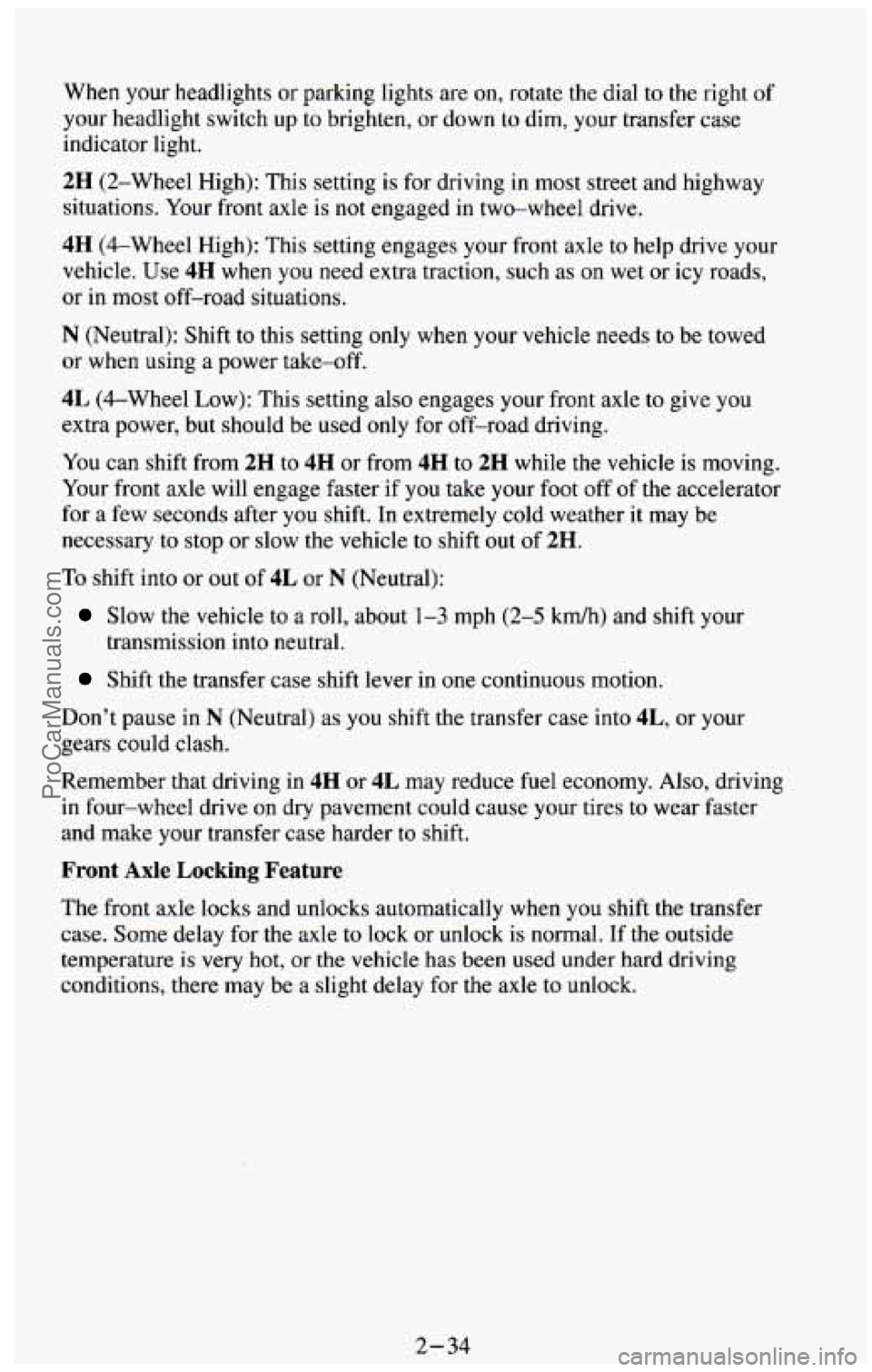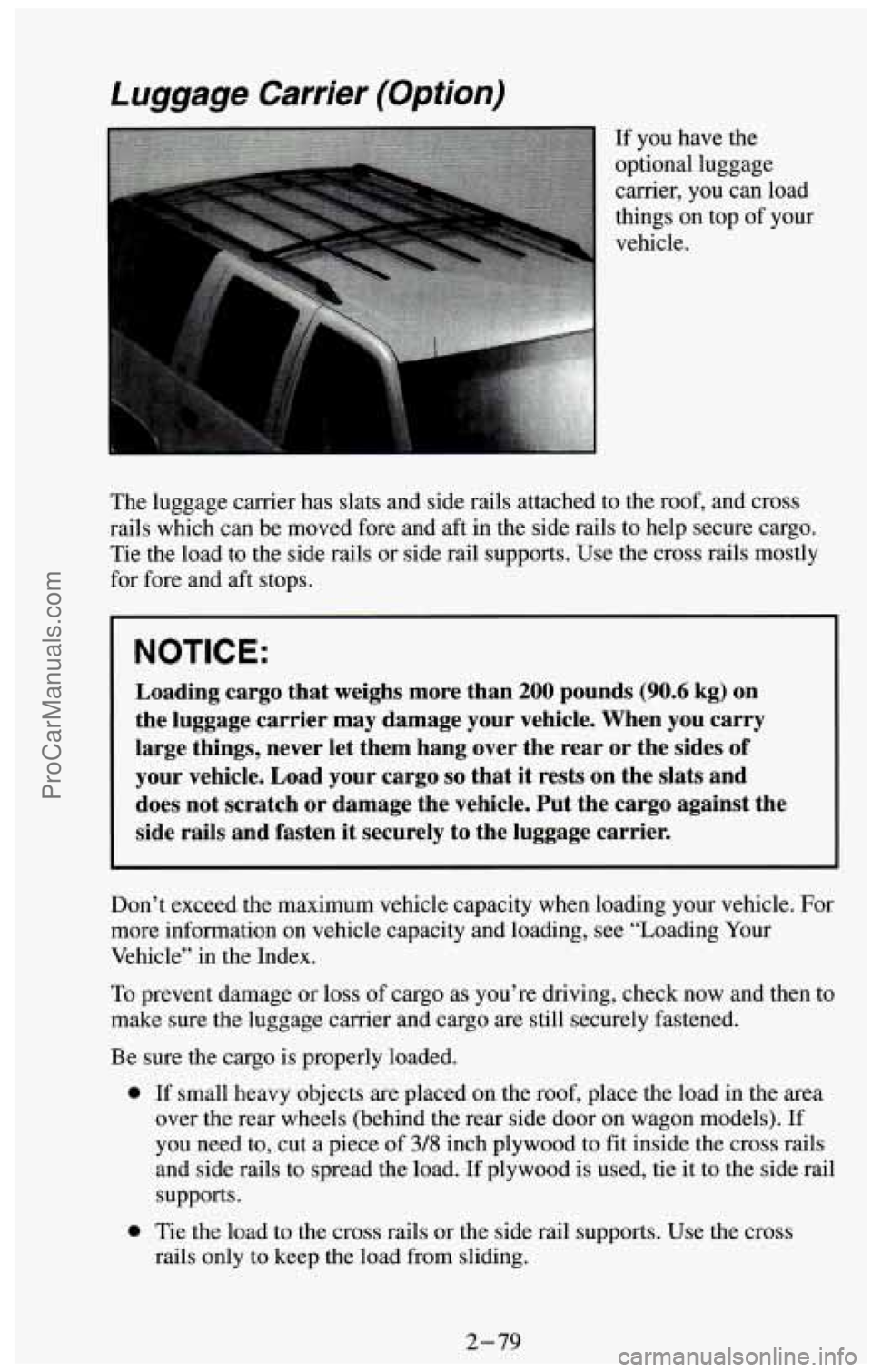Page 88 of 385
NOTICE:
Driving in the 4H or 4L positions for a long time on dry or wet
pavement
could shorten the life of your vehicle’s drivetrain.
Transfer Case
The transfer case shift
lever
is on the floor to
the right
of the driver.
Use this lever to shift
into and out
of
four-wheel drive.
An indicator near the lever
shows you the transfer case settings.
The front axle portion
of the indicator
diagram will light
up
when you shift into
four-wheel drive.
Some delay between shifting and the indicator’s lighting
is normal. If the
indicator light does
not light up, or if the front axle light does not go out
after
you shift out of four-wheel drive, have your dealer check your system.
2-33 ProCarManuals.com
Page 89 of 385

When your headlights or parking lights are on, rotate the dial to the right of
your headlight switch up to brighten, or down to dim, your transfer case
indicator light.
2H (2-Wheel High): This setting is for driving in most street and highway
situations. Your front axle
is not engaged in two-wheel drive.
4H (&Wheel High): This setting engages your front axle to help drive your
vehicle. Use
4H when you need extra traction, such as on wet or icy roads,
or
in most off-road situations.
N (Neutral): Shift to this setting only when your vehicle needs to be towed
or when using a power take-off.
4L (4-Wheel Low): This setting also engages your front axle to give you
extra power, but should be used only for off-road driving.
You can shift from
2H to 4H or from 4H to 2H while the vehicle is moving.
Your front axle will engage faster if
you take your foot off of the accelerator
for a few seconds after you shift. In extremely cold weather
it may be
necessary to stop or slow the vehicle to shift out of
2H.
To shift into or out of 4L or N (Neutral):
Slow the vehicle to a roll, about 1-3 mph (2-5 kdh) and shift your
Shift the transfer case shift lever in one continuous motion.
transmission into neutral.
Don’t pause
in N (Neutral) as you shift the transfer case into 4L, or your
gears could clash.
Remember that driving in
4H or 4L may reduce fuel economy. Also, driving
in four-wheel drive on dry pavement could cause your tires to wear faster
and make your transfer case harder to shift.
Front Axle Locking Feature
The front axle locks and unlocks automatically when you shift the transfer
case. Some delay for the axle to lock or unlock is normal. If the outside
temperature is
very hot, or the vehicle has been used under hard driving
conditions, there may be a slight delay for the axle to unlock.
2-34
ProCarManuals.com
Page 92 of 385
Horn
To sound the horn,
press the pad in the
center of the steering
wheel. The pad has a
Tilt Wheel (Option)
A tilt steering wheel allows you to adjust the steering wheel before you
drive.
You can raise it to the highest level to give your legs more room when you
exit and enter the vehicle.
To adjust the tilt steering wheel:
0 While holding the
steering wheel,
pull the lever
toward you.
0 Move the steering
wheel to a
comfortable
level, then release
the lever to lock
the wheel in
place.
2-37
ProCarManuals.com
Page 109 of 385
Some visors have an
extender on the inside
edge. When the visor
is down, pull the
extender out for extra
glare coverage at the
front or side.
Some visors have
mirrors with lights.
If
the mirror has lights,
they will come on
when you lift the
mirror cover.
Rear Window Wiper and Washer
The rear window
wipedwasher switch
is
on your instrument
panel,
to the right of
the steering wheel.
0 To turn the wiper on, slide the lever to the right.
2-54
ProCarManuals.com
Page 134 of 385

Luggage Carrier (Option)
The luggage carrier has slats and side rails attached to the roof, and cross
rails which can be moved fore and aft in the side rails to help secure cargo.
Tie the load
to the side rails or side rail supports. Use the cross rails mostly
for fore and aft stops.
NOTICE:
Loading cargo that weighs more than 200 pounds (90.6 kg) on
the luggage carrier may damage your vehicle. When you carry
large things, never let them hang over the rear or the sides of
your vehicle. Load your cargo
so that it rests on the slats and
does not scratch or damage the vehicle. Put the cargo against the
side rails and fasten
it securely to the luggage carrier.
Don’t exceed the maximum vehicle capacity when loading your vehicle. For
more information on vehicle capacity and loading, see “Loading Your
Vehicle” in the Index.
To prevent damage or loss of cargo as you’re driving, check now and then to
make sure the luggage carrier and cargo are still securely fastened.
Be sure the cargo is properly loaded.
0 If small heavy objects are placed on the roof, place the load in the area
over the rear wheels (behind the rear side door
on wagon models). If
you need to, cut a piece of 3/8 inch plywood to fit inside the cross rails
and side rails to spread the load.
If plywood is used, tie it to the side rail
supports.
0 Tie the load to the cross rails or the side rail supports. Use the cross
rails only
to keep the load from sliding.
2-79
ProCarManuals.com
Page 140 of 385
Air Vents
If your vehicle does not have air conditioning, there are air vents below the
instrument panel.
Use the handles below
your steering wheel, with the vent symbols
on them, to open and
close the vents.
%$$$ * 2, ,.' !';."." ,i ':* 2 p*~$;mP$ .',.;"X,, ,., I If your vehicle has air
conditioning, you will
find air vents in the
center and on the sides
of your instrument
panel.
You can move the vents grilles from side to side or up and down to direct
the flow
of air, or close the vents altogether.
When you close a vent, it will increase the flow of air coming out
of any
vents that are open.
3-3
ProCarManuals.com
Page 160 of 385

Your Driving and the Road
Section
1
Here you’ll find information about driving on different kinds of roads and in
varying weather conditions
. We’ve also included many other useful tips on
driving .
.............................. 4-2
Defensive Driving ..........
DrunkenDriving ........................................... 4-2
Control
of a Vehicle
Braking
... ........................................... 4-5
Steering
................................................ 4-7
Steering Tips
............................................ 4-7
Off-Road Recovery
...................................... 4-9
Passing
................................................ 4-9
LossofControl
......................................... 4-10
Off-Road Driving With Your Four-wheel Drive Vehicle
.......... 4-12
DrivingatNight
........................................... 4-23
Driving
in the Rain ........................................ 4-24
CityDriving
.............................................. 4-26
Freeway Driving
.......................................... 4-27
Hill and Mountain Roads
.................................... 4-29
Winter Driving
............................................ 4-30
Powerwinches
........................................... 4-34
PowerTake-Off(PT0)
..................................... 4-34
Towing a Trailer
........................................... 4-36
4-1
ProCarManuals.com
Page 165 of 385

Anti-Lock Brakes (ABS)
Your vehicle has an advanced electronic braking system that can help you
keep it under control. When you start your vehicle and begin to drive away,
you may hear a momentary motor or clicking noise. This is the ABS system
testing itself.
..>
Here's how anti-lock works. Let's say the road is wet. You're driving safely.
Suddenly an animal jumps out in front of you.
You slam
on the brakes. Here's what happens with ABS.
. ...
A computer senses that wheels are slowing down. If one of the wheels is
about to stop rolling, the computer will separately work the brakes at each
front wheel and at the rear wheels. The anti-lock system can change the
brake pressure faster than any driver could. The computer is programmed to
make the most
of available tire and road conditions. You can steer around
the obstacle while braking hard.
'.." *!
As you brake, your computer keeps receiving updates on wheel speed and
controls braking pressure accordingly.
4-6
ProCarManuals.com